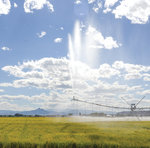Cloudy, 26° F
Getting water to crops has been a challenge for Big Horn Basin farmers since the first homesteaders cleared fields of scrub brush with horses.
The typical means to irrigate has been furrow …
This item is available in full to subscribers.
The Powell Tribune has expanded its online content. To continue reading, you will need to either log in to your subscriber account, or purchase a subscription.
If you are a current print subscriber, you can set up a free web account by clicking here.
If you already have a web account, but need to reset it, you can do so by clicking here.
If you would like to purchase a subscription click here.
Please log in to continue |
|


Getting water to crops has been a challenge for Big Horn Basin farmers since the first homesteaders cleared fields of scrub brush with horses.
The typical means to irrigate has been furrow irrigation. Water is siphoned from ditches or released from pipes down trenches running between rows of crops. The method worked pretty well for decades, and the irrigation infrastructure is in place to support the system with a series of dams, canals, laterals and ditches.
However, this method also requires a lot of manual labor and produces a lot of runoff, which takes valuable topsoil and fertilizer with it.
As farming continues to evolve and implement more efficiencies, sprinkler irrigation is becoming commonplace across the Big Horn Basin.
“I think everybody will go to it eventually,” said Jerry Thompson.
Thompson and his wife, Ruth, own Waterworks Irrigation in Ralston. The business provides a range of services for irrigation needs, including gated pipe, which is another form of furrow irrigation. With gated pipe, instead of siphoning water from ditches, the water runs down pipes with holes on the side, which are open and closed with gates.
There are a few types of sprinkler systems, including center pivot irrigation, in which an arm moves around a center point. These form the rows of circular fields seen when flying over large areas of farmland. There are also systems that move in a straight line, sometimes called side-roll irrigation systems.
Different methods propel the lines of sprinklers forward. Originally, the systems used the pressure of the water to turn the wheels. Today, electric motors and hydraulic do the work.
Thompson sells systems that use hydraulic motors, which require only 24 volts. Electric motor systems use over 400 volts. When you’re working with water and electricity, it’s safer to have lower voltage, Thompson said.
They sell manually operated systems and those with “full-blown” computer automation. He said the older farmers tend to prefer manual systems, whereas the younger ones want all the GPS, phone apps, and bells and whistles. A fully automated system allows farmers to monitor and control their sprinkler systems from their phones.
All these various approaches are catching on little by little and replacing conventional methods.
“It’s definitely moving into the area and being viewed favorably,” said Jeremiah Vardiman, University of Wyoming Extension agriculture and horticulture educator in Powell.
Vardiman said a main driver of the switch is labor costs.
The technology is a big investment, but with savings they provide, they typically pay for themselves in 10 to 15 years.
Ric Rodriguez, who farms in the Heart Mountain area, began using pivot irrigation about 15 years ago. He’s been adding a system every three to four years and now has about half of his 3,000 acres under pivot irrigation systems.
Rodriguez’s operation used to require about 10 irrigators, but he now only needs about five. Besides the expense, he said it’s often difficult to fill the positions these days.
“It’s hard to find good irrigators,” Rodriguez said.
The pivot systems also save on fertilizer. Furrow irrigation tends to wash a lot of the fertilizer application away. The sprinklers on a pivot rain down water upon the crops evenly with less movement over the soil.
This also allows for higher yields in some cases, as it applies water a bit more precisely over the field. With furrow irrigation, some areas get too wet and others not wet enough.
Val Murray, co-owner of Murraymere Farms, said her family’s farming operation is in the first year of using sprinkler systems. They placed just under a fourth of their acreage under pivot sprinkler systems, which was paid for by a cost-share program available through the Natural Resources Conservation Service.
“It saves time, fuel and man hours,” Murray said.
Besides the savings on overhead costs, she pointed to the valuable benefit of preserving topsoil. Their runoff had a lot of silt in it, and the sprinklers will help prevent that erosion.
She also mentioned the crops under the sprinklers are looking good.
“They’re happy crops,” Murray said.
Rory Karhu, district conservationist with the NRCS, said the cost-share program has been around since the 1990s; it is under the USDA and funded through the U.S. Farm Bill. In terms of conservation, the program helps pay for the costs of irrigation efficiencies and improved water quality.
“As it so happens, pivot irrigation is a great way to achieve that,” Karhu said.
The southern part of the Big Horn Basin has seen the sprinklers implemented sooner, and it’s just started to catch on more up here in the Powell area.
Karhu said there was some additional funding in the Worland area, which helped spur its implementation sooner down there.
Since 2005, he’s seen approvals for about 90 to 95 pivots in Park County.
Thompson, of Waterworks, said installing a pivot system usually starts with looking at a map of the field to be put under sprinkler irrigation. That gives them a close size of the system to be built, and they can come up with an initial estimate. They then do some site visits and take more measurements. They make some changes to the plans based on that, and the system is ready to go. The whole thing can take one or two months.
“That’s if everything falls into place,” Thompson said.
He said people who avail themselves of the government cost-share programs often have to submit plans and specs for federal approval. In that case, it can take six months or more for things to be up and running.
After it’s set up, it can still take a while to get it running smoothly; Murray said they’re working out all the kinks.
“The first year is a learning curve,” she said.